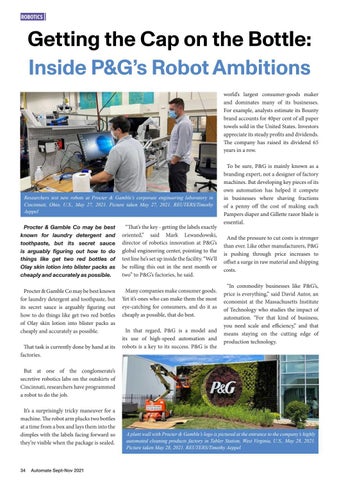Getting the Cap on the Bottle: Inside P&G’s Robot Ambitions world’s largest consumer-goods maker and dominates many of its businesses. For example, analysts estimate its Bounty brand accounts for 40per cent of all paper towels sold in the United States. Investors appreciate its steady profits and dividends. The company has raised its dividend 65 years in a row.
Researchers test new robots at Procter & Gamble’s corporate engineering laboratory in Cincinnati, Ohio, U.S., May 27, 2021. Picture taken May 27, 2021. REUTERS/Timothy Aeppel
Procter & Gamble Co may be best known for laundry detergent and toothpaste, but its secret sauce is arguably figuring out how to do things like get two red bottles of Olay skin lotion into blister packs as cheaply and accurately as possible.
“That’s the key - getting the labels exactly oriented,” said Mark Lewandowski, director of robotics innovation at P&G’s global engineering center, pointing to the test line he’s set up inside the facility. “We’ll be rolling this out in the next month or two” to P&G’s factories, he said.
Procter & Gamble Co may be best known for laundry detergent and toothpaste, but its secret sauce is arguably figuring out how to do things like get two red bottles of Olay skin lotion into blister packs as cheaply and accurately as possible.
Many companies make consumer goods. Yet it’s ones who can make them the most eye-catching for consumers, and do it as cheaply as possible, that do best.
That task is currently done by hand at its factories.
In that regard, P&G is a model and its use of high-speed automation and robots is a key to its success. P&G is the
To be sure, P&G is mainly known as a branding expert, not a designer of factory machines. But developing key pieces of its own automation has helped it compete in businesses where shaving fractions of a penny off the cost of making each Pampers diaper and Gillette razor blade is essential. And the pressure to cut costs is stronger than ever. Like other manufacturers, P&G is pushing through price increases to offset a surge in raw material and shipping costs. “In commodity businesses like P&G’s, price is everything,” said David Autor, an economist at the Massachusetts Institute of Technology who studies the impact of automation. “For that kind of business, you need scale and efficiency,” and that means staying on the cutting edge of production technology.
But at one of the conglomerate’s secretive robotics labs on the outskirts of Cincinnati, researchers have programmed a robot to do the job. It’s a surprisingly tricky maneuver for a machine. The robot arm plucks two bottles at a time from a box and lays them into the dimples with the labels facing forward so they’re visible when the package is sealed.
34
Automate Sept-Nov 2021
A plant wall with Procter & Gamble’s logo is pictured at the entrance to the company’s highly automated cleaning products factory in Tabler Station, West Virginia, U.S., May 28, 2021. Picture taken May 28, 2021. REUTERS/Timothy Aeppel




























